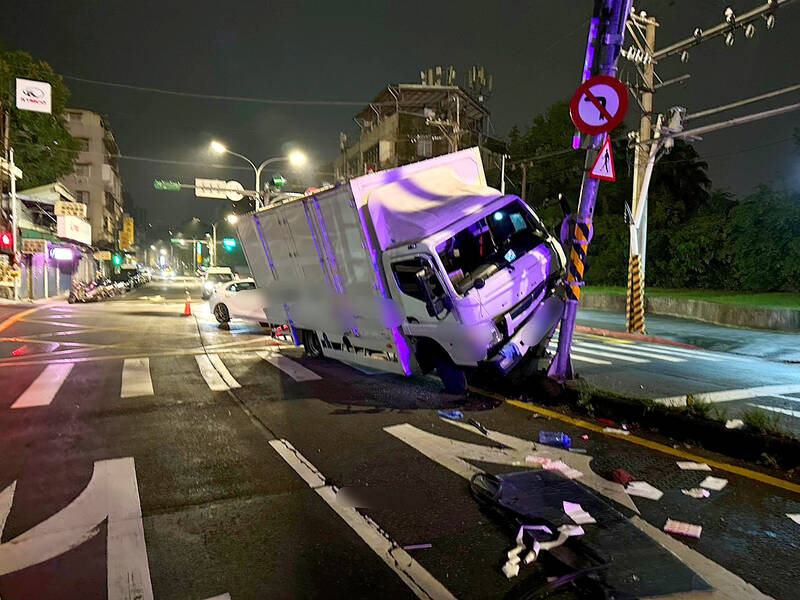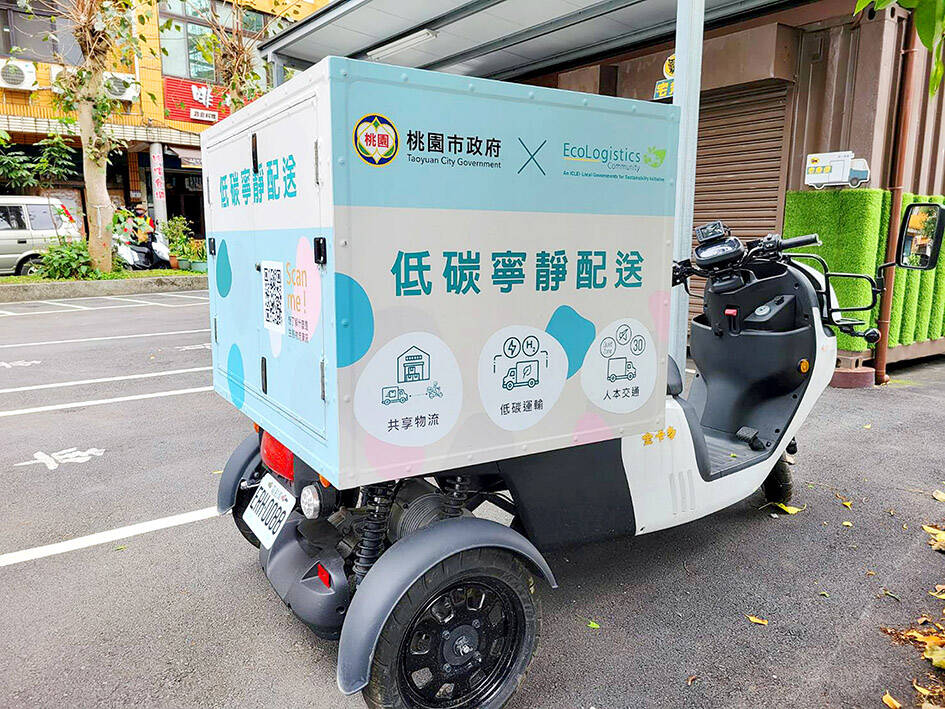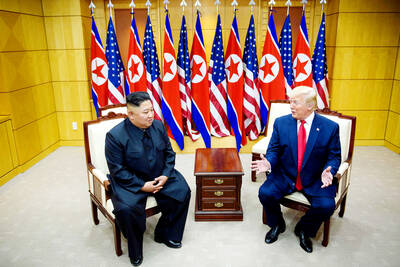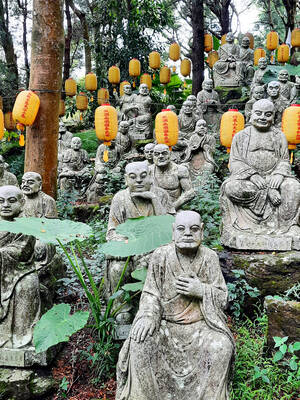Apart from the goods they carry, delivery trucks bring nothing positive to urban areas. The majority burn diesel or gasoline, and drivers often leave the engines running while making deliveries, exacerbating air pollution.
When these vehicles block the street, they delay other road users, causing frustration as well as yet more carbon dioxide to enter the atmosphere. By occupying sidewalks and creating blind spots, they increase the risk of accidents, especially for those on foot. If local governments do designate loading/unloading zones, typically they reduce the space available for pedestrians and cyclists. What’s more, trucks are noisy.
But it doesn’t have to be this way. An intriguing experiment in Taoyuan’s Dasi District (大溪) suggests that, when government entities cooperate with NGOs and private businesses, it’s possible to alleviate these negative externalities.

Photo: Lu Yun-fung, Taipei Times
Dasi’s Low Carbon and Quiet Consolidation Center (LCQCC) project recognized that, within conventional delivery ecosystems, there’s a vast amount of duplication. In busy neighborhoods, it’s not unusual to see a vehicle drop off a package at one address, then, a short time later, see another approach from the same direction and deliver something to the building next door. The center, the first of its kind in Taiwan, aimed to lessen the environmental footprint of the final stage of the manufacturer-to-consumer journey.
In a recent white paper published by the World Economic Forum (WEF), researchers noted that the rapid growth of e-commerce has led to a surge in the number of delivery vehicles on urban roads, and that “[under] a business-as-usual scenario, carbon emissions from all urban delivery traffic could increase by 60 percent by 2030…[the] urgent need to transition to zero-emission fleets and shared infrastructure is evident.”
In Taiwan, a delivery truck making a stop on its regular rounds may well save the deliveree a 10-km round trip. Because some people get around by car or motorcycle, while others use public transportation, it’s hard to say if e-commerce adds to or reduces the overall environmental cost of our shopping habits — even when ignoring associated issues like excessive packaging. But whether it does or it doesn’t, there’s no good reason why logistics companies shouldn’t be pushed to make their operations as sustainable as possible.

Photo: Lu Yun-fung, Taipei Times
THE LAND QUESTION
The LCQCC initiative was launched in December 2020 as one of five eco-logistics demonstration areas proposed by the Taoyuan City Government. A parking lot 400m south of Heping Road (和平路) and the town’s touristy old quarter was converted into a facility where goods from outside the area were transferred from conventional trucks to vehicles more appropriate to a crowded urban environment. In this case, electric three-wheelers were used for the “last mile.”
Urban Consolidation Centers (UCCs), as they’re known, are nothing new. According to a July 2012 paper in Transport Reviews, more than 100 were set up in 17 countries over the previous 40 years. Some have been a success, it seems: in Monaco, the amount of kerbside space occupied by delivery vehicles fell by 42 percent after a UCC was introduced.

Photo: Chen En-hui, Taipei Times
As the WEF paper points out, real estate shortages often make creating a UCC very difficult. In addition to having enough space so trucks can unload, such facilities need electric-vehicle charging points and storage for goods awaiting delivery or pickup.
Given the crowded character of Taiwan’s urban areas, it wasn’t surprising that land issues led to the termination of the LCQCC experiment. As reported in the April 9, 2023 issue of the Liberty Times, the Chinese-language sister newspaper of the Taipei Times, a lack of parking spots in the heart of Daxi caused a backlash against the consolidation center. A few months after that report, the LCQCC was dismantled and the site became a parking lot once again.
A recent academic paper examining the LCQCC, “Advancing Sustainable Last-Mile Delivery with Collaborative Governance: Lessons from Daxi’s Low Carbon and Quiet
Consolidation Center” (Urban Policy and Research, March 3) notes that Taiwan’s logistics industry has enjoyed rapid growth in recent years, but “the absence of a national or local logistics plan addressing the industry’s sustainability is a significant gap that needs to be filled.”
The paper, authored by a team at National Cheng Kung University’s (NCKU) Department of Transportation and Communication Management Science, points out that various aspects of the industry are overseen by the Ministry of Transportation and Communications, the Ministry of Economic Affairs and the Ministry of Finance. This “siloed approach,” it goes on to say, has resulted in an “unclear allocation of resources, budgeting and guidance, making it challenging to identify and address issues” and potential solutions.
The paper recounts how setting up the LCQCC required considerable grassroots engagement, including door-to-door visits, to develop partnerships and allay business owners’ concerns that the project would interrupt their operations. The city government appointed the Takoham Environmental Sustainability Foundation (財團法人大嵙崁環境永續發展基金會) as the local coordinator. This Dasi-based entity can be described as a “government-organized NGO” or GONGO, as the initial impetus and funding came from the local government.
INADEQUATE PARTICIPATION
Kerry TJ Logistics, President Transnet and HCT Logistics — three of Taiwan’s four major last-mile delivery operators — joined the project. State-owned Chunghwa Post was the biggest but not the only holdout.
Explaining that last-mile delivery is often handled by smaller companies, the paper’s lead author tells the Taipei Times that the project would have been more successful if it had included all delivery operators. This would have created “a level playing field,” says Cheng Tsu-jui (鄭祖睿), an NCKU assistant professor.
Using a GONGO to kick off the project was a good move, he adds, but “in the long run, the operation of a consolidation center should be transferred to a local business organization. From land-use perspectives, the center could have been a good opportunity to properly plan freight loading/unloading areas and low-emissions zones in Daxi, so as to double down on the benefits of the LCQCC.”
Cheng also noticed that the project suffered from a “discontinuation of political commitment” after Simon Chang (張善政) of the Chinese Nationalist Party (KMT) succeeded Cheng Wen-tsan (鄭文燦) of the Democratic Progressive Party (DPP) as Taoyuan’s mayor.
Elsewhere in Taiwan, NCKU’s Cheng thinks close-knit neighborhoods and business improvement districts might be suitable locations for consolidation centers.
Entrepreneurs who require deliveries or pickups multiple times each week are likely to support such initiatives, especially if they’re keen to improve the overall environment for their customers. Anping (安平) in Tainan, and neighborhoods where there’s potential for pedestrianization, might be good candidates, he says.
“But the challenge remains as to how last-mile delivery can be organized. Should shops pick up their own goods or should a local business association contract a logistics company to do it?” Cheng says.
Asked if any local governments have an especially forward-thinking approach to last-mile logistics, Cheng replies: “No, because of the fragmentation of freight transportation governance here. But Taiwan isn’t alone. Globally, few local governments have this capacity.”
However, he expresses some optimism, saying: “Now that the national government is planning low-emission zones, hopefully the issue of urban freight will soon be included in their discussions.”
Steven Crook, the author or co-author of four books about Taiwan, has been following environmental issues since he arrived in the country in 1991. He drives a hybrid and carries his own chopsticks. The views expressed here are his own.

US President Donald Trump may have hoped for an impromptu talk with his old friend Kim Jong-un during a recent trip to Asia, but analysts say the increasingly emboldened North Korean despot had few good reasons to join the photo-op. Trump sent repeated overtures to Kim during his barnstorming tour of Asia, saying he was “100 percent” open to a meeting and even bucking decades of US policy by conceding that North Korea was “sort of a nuclear power.” But Pyongyang kept mum on the invitation, instead firing off missiles and sending its foreign minister to Russia and Belarus, with whom it

When Taiwan was battered by storms this summer, the only crumb of comfort I could take was knowing that some advice I’d drafted several weeks earlier had been correct. Regarding the Southern Cross-Island Highway (南橫公路), a spectacular high-elevation route connecting Taiwan’s southwest with the country’s southeast, I’d written: “The precarious existence of this road cannot be overstated; those hoping to drive or ride all the way across should have a backup plan.” As this article was going to press, the middle section of the highway, between Meishankou (梅山口) in Kaohsiung and Siangyang (向陽) in Taitung County, was still closed to outsiders

President William Lai (賴清德) has championed Taiwan as an “AI Island” — an artificial intelligence (AI) hub powering the global tech economy. But without major shifts in talent, funding and strategic direction, this vision risks becoming a static fortress: indispensable, yet immobile and vulnerable. It’s time to reframe Taiwan’s ambition. Time to move from a resource-rich AI island to an AI Armada. Why change metaphors? Because choosing the right metaphor shapes both understanding and strategy. The “AI Island” frames our national ambition as a static fortress that, while valuable, is still vulnerable and reactive. Shifting our metaphor to an “AI Armada”

The Chinese Communist Party (CCP) has a dystopian, radical and dangerous conception of itself. Few are aware of this very fundamental difference between how they view power and how the rest of the world does. Even those of us who have lived in China sometimes fall back into the trap of viewing it through the lens of the power relationships common throughout the rest of the world, instead of understanding the CCP as it conceives of itself. Broadly speaking, the concepts of the people, race, culture, civilization, nation, government and religion are separate, though often overlapping and intertwined. A government